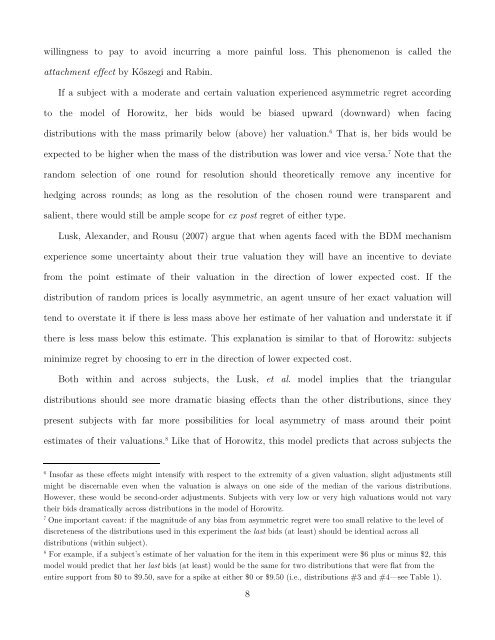Testing Distributional Dependence in the Becker-DeGroot-Marschak ...
Testing Distributional Dependence in the Becker-DeGroot-Marschak ...
Testing Distributional Dependence in the Becker-DeGroot-Marschak ...
You also want an ePaper? Increase the reach of your titles
YUMPU automatically turns print PDFs into web optimized ePapers that Google loves.
will<strong>in</strong>gness to pay to avoid <strong>in</strong>curr<strong>in</strong>g a more pa<strong>in</strong>ful loss. This phenomenon is called <strong>the</strong><br />
attachment effect by Kőszegi and Rab<strong>in</strong>.<br />
If a subject with a moderate and certa<strong>in</strong> valuation experienced asymmetric regret accord<strong>in</strong>g<br />
to <strong>the</strong> model of Horowitz, her bids would be biased upward (downward) when fac<strong>in</strong>g<br />
distributions with <strong>the</strong> mass primarily below (above) her valuation. 6 That is, her bids would be<br />
expected to be higher when <strong>the</strong> mass of <strong>the</strong> distribution was lower and vice versa. 7 Note that <strong>the</strong><br />
random selection of one round for resolution should <strong>the</strong>oretically remove any <strong>in</strong>centive for<br />
hedg<strong>in</strong>g across rounds; as long as <strong>the</strong> resolution of <strong>the</strong> chosen round were transparent and<br />
salient, <strong>the</strong>re would still be ample scope for ex post regret of ei<strong>the</strong>r type.<br />
Lusk, Alexander, and Rousu (2007) argue that when agents faced with <strong>the</strong> BDM mechanism<br />
experience some uncerta<strong>in</strong>ty about <strong>the</strong>ir true valuation <strong>the</strong>y will have an <strong>in</strong>centive to deviate<br />
from <strong>the</strong> po<strong>in</strong>t estimate of <strong>the</strong>ir valuation <strong>in</strong> <strong>the</strong> direction of lower expected cost. If <strong>the</strong><br />
distribution of random prices is locally asymmetric, an agent unsure of her exact valuation will<br />
tend to overstate it if <strong>the</strong>re is less mass above her estimate of her valuation and understate it if<br />
<strong>the</strong>re is less mass below this estimate. This explanation is similar to that of Horowitz: subjects<br />
m<strong>in</strong>imize regret by choos<strong>in</strong>g to err <strong>in</strong> <strong>the</strong> direction of lower expected cost.<br />
Both with<strong>in</strong> and across subjects, <strong>the</strong> Lusk, et al. model implies that <strong>the</strong> triangular<br />
distributions should see more dramatic bias<strong>in</strong>g effects than <strong>the</strong> o<strong>the</strong>r distributions, s<strong>in</strong>ce <strong>the</strong>y<br />
present subjects with far more possibilities for local asymmetry of mass around <strong>the</strong>ir po<strong>in</strong>t<br />
estimates of <strong>the</strong>ir valuations. 8 Like that of Horowitz, this model predicts that across subjects <strong>the</strong><br />
6 Insofar as <strong>the</strong>se effects might <strong>in</strong>tensify with respect to <strong>the</strong> extremity of a given valuation, slight adjustments still<br />
might be discernable even when <strong>the</strong> valuation is always on one side of <strong>the</strong> median of <strong>the</strong> various distributions.<br />
However, <strong>the</strong>se would be second-order adjustments. Subjects with very low or very high valuations would not vary<br />
<strong>the</strong>ir bids dramatically across distributions <strong>in</strong> <strong>the</strong> model of Horowitz.<br />
7 One important caveat: if <strong>the</strong> magnitude of any bias from asymmetric regret were too small relative to <strong>the</strong> level of<br />
discreteness of <strong>the</strong> distributions used <strong>in</strong> this experiment <strong>the</strong> last bids (at least) should be identical across all<br />
distributions (with<strong>in</strong> subject).<br />
8 For example, if a subject’s estimate of her valuation for <strong>the</strong> item <strong>in</strong> this experiment were $6 plus or m<strong>in</strong>us $2, this<br />
model would predict that her last bids (at least) would be <strong>the</strong> same for two distributions that were flat from <strong>the</strong><br />
entire support from $0 to $9.50, save for a spike at ei<strong>the</strong>r $0 or $9.50 (i.e., distributions #3 and #4—see Table 1).<br />
8


